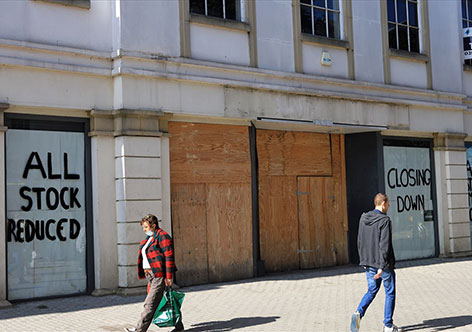Key Highlights
- The yield differential between US 2-year and 10-year Treasury yields has turned flat or negative
- Investors are concerned that this signals an impending recession, as happened in the past
- However, economic indicators are still important to watch, and these suggest a slowing but positive trend
What happened to the yield curve last week?
Bond markets are abuzz with speculation. A phenomenon that is relatively rare but psychologically important has become the focus for many investors, i.e. the on and off inversion of the yield curve.
Over a volatile few days last week, the 10-year US Treasuries yield reached 2.54 per cent on Monday, its highest point of the week, and fell to 2.32 per cent on Thursday, its lowest point of the week. These levels were uncomfortably close to the 2-year Treasury yields, which ranged from 2.45 to 2.27 per cent over the week.
And at times, 10-year yields were trading lower than 2-year yields. This is called an inverted yield curve and is seen by the market as a reliable indicator that a recession is on the cards for the US. This is because a yield curve inversion has occurred six out of the seven recessions seen in the US since 1978.
Why is an inverted yield curve so ominous?
In a standard period of good growth expectations, yields of longer-term bonds can be expected to be higher than those of shorter-term bonds. Investors holding longer-term bonds are taking more duration risk, so yields increase as durations extend.
This is because the further out that you venture into the future, the greater the uncertainties about economic outcomes. Investors would expect to be rewarded for taking this additional risk and the long-term average spread between 2 and 10-year Treasuries is about 90 bps.
However, there are times when this spread becomes tighter. This happens when the US Federal Reserve is expected to aggressively raise interest rates, thereby pushing up short-term yields. On the other hand, the demand for longer-term bonds is subdued given market concerns that higher rates will hurt the economy. As such, their yields fail to keep pace. In extreme cases, the yields of shorter-term bonds start to equal or overtake their longer-term counterparts, leading to a yield curve inversion.
Self-fulfilling prophecy?
The table below shows that since 1955, rate hikes are indeed eventually followed by a recession but this can take at least a year and is more commonly between two or three years.
Figure 1: Recessions tend to start only several years after the start of rate rises
| Hikes begin | Recession starts* |
| Apr-55 | 28 |
| Sep-58 | 19 |
| Nov-67 | 25 |
| Mar-72 | 20 |
| Dec-76 | 37 |
| Aug-80 | 11 |
| May-83 | 86 |
| Dec-86 | 43 |
| Mar-88 | 28 |
| Feb-94 | 85 |
| Jun-99 | 21 |
| Jun-04 | 42 |
| Dec-16 | 38 |
| Median | 28 |
| Trimmed Median | 37 |
Source: UOBAM/State Street
*Number of months following the beginning of interest rates hikes
Usually, central banks try to ease in their rate hikes gradually in order not to stall economic growth. The Russia-Ukraine war has not afforded the world this luxury. Instead, rising energy prices, sanctions, and other disruptions have pushed inflation to multi-year highs, forcing central banks like the Fed to signal a faster-than-usual schedule of hikes.
However, it is worth understanding, for any sustained period of yield curve inversion, whether it is the upcoming recession that is causing the curve to invert, or whether in fact, it is the inverted yield curve that has to potential to cause a recession.
Campbell Harvey, professor of finance at the Fuqua School of Business, Duke University, is a pioneer of the concept of yield curves as a predictor of recessions. He noted that this intense market focus could be a self-fulfilling prophecy, that is, people and businesses start to change their behaviours and spend or invest less, thereby precipitating rather than reacting to a recession.
Bond vs equity markets
It is the idea that an inverted yield curve is not a signal, but a reason, for slowing growth that could help explain the fact that equity markets are trending in the opposite direction to bond markets.
Instead of the shape of the yield curve, equity investors are looking instead at indicators such as company earnings upgrades, employment data and the Purchasing Managers Index (PMI) to assess whether a recession is indeed imminent. These indicators appear to tell a different story. For example, although the first-quarter earnings season has not begun in earnest, last week seven S&P 500 companies reported 1Q earnings and five of them beat consensus EPS expectations.
It is positive news like this that has helped calm US equity markets despite the ongoing Russia-Ukraine conflict, with the S&P500 now 5.2 per cent above where it was a month ago.
Recession not our base case
As multi-asset portfolio managers, UOBAM closely watches both bond and equity market signals. Despite the current flatness of the yield curve, we have not changed our base case that economies are set to expand moderately over the next few months.
We would note that the yield spread between the 3-month and 18-month Treasuries, a measure that the Fed referenced recently, remains positive and fairly steep. However, we would expect this not to last, and for this curve to also invert over the next three months.
However, once a yield curve flattens or invests, there is a tendency for bond yields to fall (i.e. bond prices to rise) since they are not able to move higher in a parallel manner. As such, we would expect yields of 10-year Treasuries to trade within a 2.0 to 2.25 per cent range over the next few months.
This publication shall not be copied or disseminated, or relied upon by any person for whatever purpose. The information herein is given on a general basis without obligation and is strictly for information only. This publication is not an offer, solicitation, recommendation or advice to buy or sell any investment product, including any collective investment schemes or shares of companies mentioned within. Although every reasonable care has been taken to ensure the accuracy and objectivity of the information contained in this publication, UOB Asset Management Ltd (“UOBAM”) and its employees shall not be held liable for any error, inaccuracy and/or omission, howsoever caused, or for any decision or action taken based on views expressed or information in this publication. The information contained in this publication, including any data, projections and underlying assumptions are based upon certain assumptions, management forecasts and analysis of information available and reflects prevailing conditions and our views as of the date of this publication, all of which are subject to change at any time without notice. Please note that the graphs, charts, formulae or other devices set out or referred to in this document cannot, in and of itself, be used to determine and will not assist any person in deciding which investment product to buy or sell, or when to buy or sell an investment product. UOBAM does not warrant the accuracy, adequacy, timeliness or completeness of the information herein for any particular purpose, and expressly disclaims liability for any error, inaccuracy or omission. Any opinion, projection and other forward-looking statement regarding future events or performance of, including but not limited to, countries, markets or companies is not necessarily indicative of, and may differ from actual events or results. Nothing in this publication constitutes accounting, legal, regulatory, tax or other advice. The information herein has no regard to the specific objectives, financial situation and particular needs of any specific person. You may wish to seek advice from a professional or an independent financial adviser about the issues discussed herein or before investing in any investment or insurance product. Should you choose not to seek such advice, you should consider carefully whether the investment or insurance product in question is suitable for you.





